Nam Prik Pao is an essential Thai chili paste, known as "Thai chili jam.” If you are looking for a quick win in the kitchen that can upgrade everything from grilled foods to noodle dishes like pad wood sen, this recipe is your secret weapon!

Like the chili jam that is always found in Thai restaurants, and kitchen tables in Thai households this vegan Nam Prik Pao recipe stays true to the condiment’s traditional roots. Except, instead of shrimp paste, the umami notes come from intensely flavorful plant-based ingredients!
Nam Prik Pao translates to "roasted chili water" in Thai. The title is a poetic homage to the process of slow-cooking fiery chilies and fragrant ingredients to create a potent elixir that awakens the senses. Drizzle some into bánh bao chay, dip vegan Thai spring rolls, or rice dumplings into it, or use it to bring your Khao Suey to the next level.
Follow this recipe and discover why this chilli paste sits on restaurant tables all over Thailand, beckoning diners into the fiery embrace of its seductive heat. Let’s whip a jar of this up together!
Jump to:
🥰Why you are going to adore the ever-loving heck outta this recipe
🌱 Vegan AF and GF: All of my Thai recipes are plant-based, but this one also happens to be gluten-free! No dried shrimp to be found here!
🌶️ Superior Ingredient Choices: Our careful selection of dried chilies, shallots, and garlic ensures a perfect balance of flavors. No more guesswork, just the ideal combination for that authentic Thai taste.
✅ Tested and Approved Worldwide: Like all of the recipes on my blog, after refining the recipe, I sent this Nam Prik Pao recipe to a large group of recipe testers from all over the world. It has undergone rigorous testing and works seamlessly with different ingredients and equipment, ensuring your culinary success no matter where you are.
🌶️ Notable ingredients and substitutions

Dried Chilies
Dried chilies are the fiery foundation of this chili sauce, infusing it with intense heat and a deep, smoky flavor. Spur chiles are the authentic chili to use, but Thai chili flakes (which I use to make nam jim jaew) also work great. Other chili peppers I like to make this with are Byadagi chilies from India, or Arbol chilies, which pack a little more heat.
Shallots
Shallots provide a sweet, aromatic undertone to the chili paste. Shallots are essential in Thai cuisine, and throughout Southeast Asia, especially in condiments like sambal dabu dabu, sambal matah and this here nam prik pao! If you can't find them, red onions are a fine substitute.
Tamarind Concentrate
Tamarind concentrate, called Makham Pi in Thai, offers a harmonious balance of tartness and sweetness to Nam Prik Pao. It’s essential in making tom yum paste, and rice paper salad. In case you can't find tamarind paste, you can make your own by blending tamarind pulp with boiling water until smooth and thick. If both store-bought and homemade paste are entirely out of the question, some Thai cooks make this spicy jam with lime juice instead.
Palm Sugar
Sweetness in Nam Prik Pao comes from your choice of palm, coconut, or brown sugar. Palm sugar, which is the sweetener of choice in desserts like klepon and bubur sumsum is traditionally used, with its rich, caramel-like flavor.
Vegetarian Fish Sauce
Plant-based fish sauce mimics the umami richness of traditional fish sauce without killing all the fish in the ocean who are just down there sitting in rocking chairs reading the newspaper, minding their own business! If you can't find it, a combination of miso and vegetarian oyster sauce can somewhat replicate the complex flavors of vegetarian fish sauce, though it will be a little thicker.
*See the recipe card at the bottom of the page for exact quantities, nutritional info, and detailed cooking directions.
🤯Variations
Nam Prik Ong
If you want to explore regional variations of Nam Prik Pao, try "Nam Prik Ong" from Northern Thailand. This chili paste is milder and features ground tofu, tomatoes, and aromatic Thai herbs like galangal. It's a delightful twist that retains the essence of the original while introducing unique flavors and textures. It's an excellent variation for those who enjoy a less spicy, more savory chili paste.
Nam Prik Pao Naam Jeow
In Laos, you'll find "Nam Prik Pao Naam Jeow," a variation that blends the sweetness of palm sugar and the heat of chilies with the added richness of fermented fish sauce. To make this sweet chilli jam vegan, I recommend adding a spoonful of taucu (fermented bean paste), and a tiny dash of rice vinegar to emulate the umami of the fermented fish sauce.
📖 How to make perfect Nam Prik Pao
Nail this Thai chili jam on your first shot by following these step-by-step instructions with important tips. Or you can follow along with the easy-to-print recipe card towards the bottom of this page.

Step One
Toast the Dried Chillies:
In a dry skillet or wok over medium heat, toast the dried chilies for 3-4 minutes until they become fragrant and slightly darkened. Once roasted, set them aside.

Step Two
Dry Sauté Shallots and Garlic:
In the same skillet, without using oil, add the thinly sliced shallots or red onions and garlic cloves. Stir over medium heat for approximately 4 minutes until they become softened and lightly charred brown. Remove them from the skillet and set them aside.

Step Three
Blend the Chilies:
Using a blender or food processor, process the toasted dried chilies until they turn into fine flakes or a powder. If you prefer a milder spice level, you can remove the seeds before blending.

Step Four
Combine Shallots and Garlic:
Add the cooked shallots and garlic to the food processor or blender. Blend until you achieve a mostly-smooth paste.

Step Five
Cook the Paste:
Transfer the chili paste back to the skillet with the oil. Cook it over low to medium heat for about 12-15 minutes, stirring occasionally until the paste becomes fragrant and the oil starts to separate.

Step Six
Add Sweet and Sour Elements:
Mix in tamarind concentrate, palm sugar (or coconut sugar, or brown sugar), vegetarian fish sauce, and salt to the cooking chili paste. Cook for an additional 3 minutes, stirring, until the sugar dissolves and a thick paste forms.
✅ For an even spicier jam: add some fresh chilies too! This is a great place to add a few sliced bird's eye chilies, or sliced cayenne chillies to the mix.

Step Seven
Cool and Store:
Let the Thai chilli jam cool to room temperature, settling into a somewhat oily, jam-like consistency. Then either get drizzlin' the stuff all over some vegan pad kee mau, or pad see ew! Otherwise, transfer it to a glass jar or airtight sterilized jar (make sure the rubber sals are good too), and store it in the refrigerator for up to a month, or portion it into an ice cube tray for long-term storage in the freezer.
✅ Didja just make your Thai basil eggplant too spicy by going overboard with this chiki jam? Cool your whole face off by pouring vegan Thai tea all over yourself, or like, you can just drink it too.
💡Serving Ideas
For noodle lovers, drizzle nam prik pao over dishes like bihun goreng, mi xao xi dau, bami goreng, ketoprak, or mie goreng for an extra kick of flavor and heat. A jar on the table is the perfect way of letting the wacky people you are eating with customize the heat level according to their personal taste.
You can't go wrong by marinating homemade seitan in it for grilling, or putting it all over miso-glazed eggplant, veg. bulgogi or tofu katsu. Serve ‘em up on a bed of kimchi fried rice, nasi minyak, or turmeric rice!
I love tossing pieces of vegan fried chicken with this chilli jam recipe. Then, assemble the most perfectly spicy Thai-inspired sandwiches. Don't forget to garnish them with spicy marinated cucumbers or pickled green chilies if you're a real fire freak.

👉Top tips
- Control the Heat: Maintain a watchful eye on the heat levels throughout the cooking process. Use medium heat when toasting the chilies to prevent burning, and be mindful when simmering the paste over low heat. This ensures you achieve that perfect balance of flavor without any unpleasant bitterness from the particles of chili burning in the hot oil.
- Blending Texture: When processing the toasted chilies, aim for the right semi-coarse texture. Using a good quality blender makes this wayyyyy easier. I think it’s nice to have little tiny bits of dried chili in the final result, but you can make it finer if you like.
- Sugars towards the end: In this recipe, introduce the tamarind and palm sugar at the end, so that the sugars in these ingredients don’t burn or become bitter from cooking. After adding the tamarind concentrate, sugar, vegetarian fish sauce, and salt, mix these ingredients thoroughly to dissolve the palm sugar crystals.
🤷♀️FAQ
Nam Prik Pao can be refrigerated for up to a month in an airtight container, ensuring it stays fresh for your culinary adventures.
You can portion it into an ice cube tray and freeze it for extended use, maintaining its delicious flavors. Once the portions are individually frozen in the tray, you can kick them out into a container in your freezer, so you can thaw and use a small bit at a time when needed. It's like having an instant spicy condiment on tap!
If tamarind concentrate is unavailable, and you can’t get tamarind pulp, lime juice, or a mix of tart cherry juice and brown sugar can somewhat mimic its tangy sweetness.
✌️My faves to drizzle all up with this chili sauce:
Say Hi on Social! 👋
Follow me on Instagram & Facebook for more recipes.
❤️Love this recipe? It helps me out greatly if you leave a 5-star 🌟🌟🌟🌟🌟rating in the recipe card below and maybe even leave me a lovey-dovey comment too!

Nam Prik Pao (Vegan Thai Chili Paste)
Equipment
- Food processor or blender
Ingredients
- 40 grams dried spur chiles or byadagi chilies, or arbol chilies, stems removed
- ½ cup thinly sliced shallots or red onions
- 12 cloves garlic
- ⅓ cup tamarind concentrate
- ⅓ cup palm sugar or coconut sugar, or brown sugar
- 3 tablespoons vegan fish sauce
- ½ cup canola oil vegetable oil, or peanut oil
- 1 teaspoon salt
Instructions
- Begin by toasting the dried chilies for about 4 minutes in a dry skillet or wok over medium heat until they become fragrant and slightly darkened. Remove them from the skillet and set them aside.
- In the same skillet, add the thinly sliced shallots or red onions and garlic (without oil) and stir for about 4 minutes until they are softened and lightly charred brown. Remove them from the skillet and set aside.
- In a food processor or blender blend the toasted dried chilies until they turn into fine flakes or a powder. If you prefer a milder spice level, remove the seeds before blending.
- Add the cooked shallots and garlic to the food processor or blender. Blend until you have a smooth paste.
- Transfer the chili paste back to the skillet and add the remaining oil. Cook over low to medium heat for about 12-15 minutes, stirring occasionally until the paste turns fragrant and the oil starts to separate.
- Add tamarind concentrate, palm sugar (or coconut sugar, or brown sugar), vegetarian fish sauce, and salt to the skillet. Cook for an additional 3 minutes, stirring, until the sugar dissolves and the mixture thickens.
- Allow your Nam Prik Pao to cool, then transfer it to a glass jar or airtight container. Store it in the refrigerator for up to a month, or portion it in an ice cube tray to freeze for long-term storage.


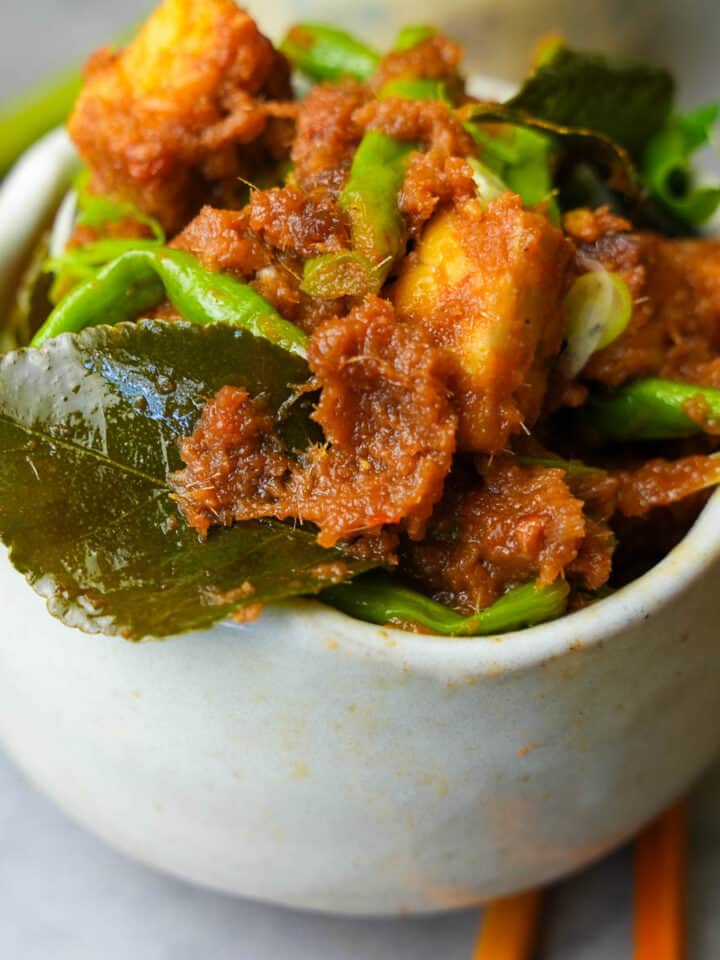
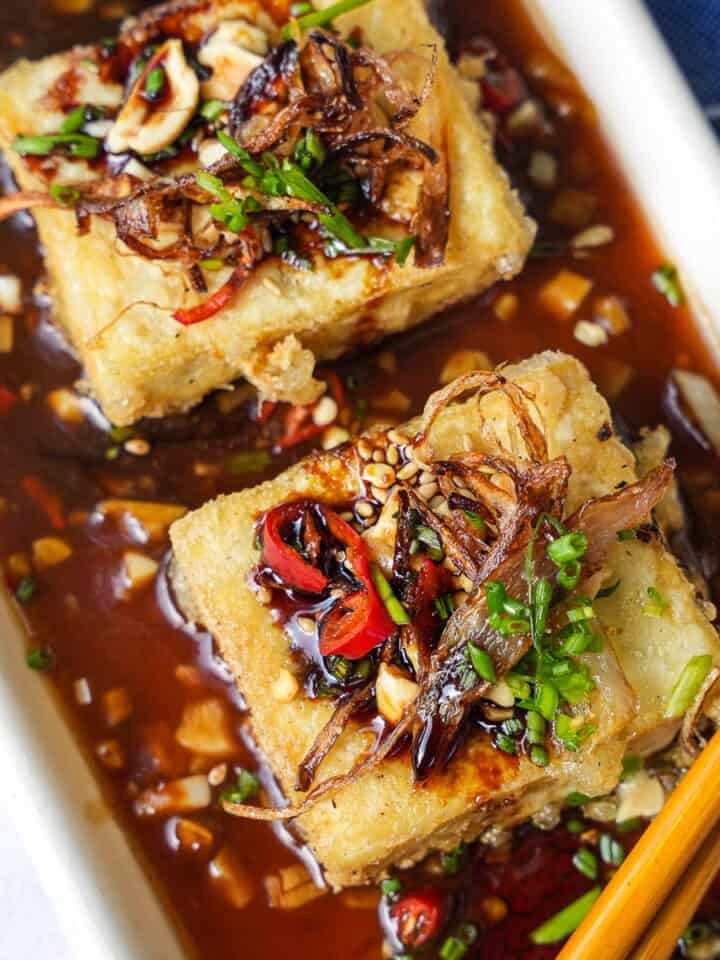

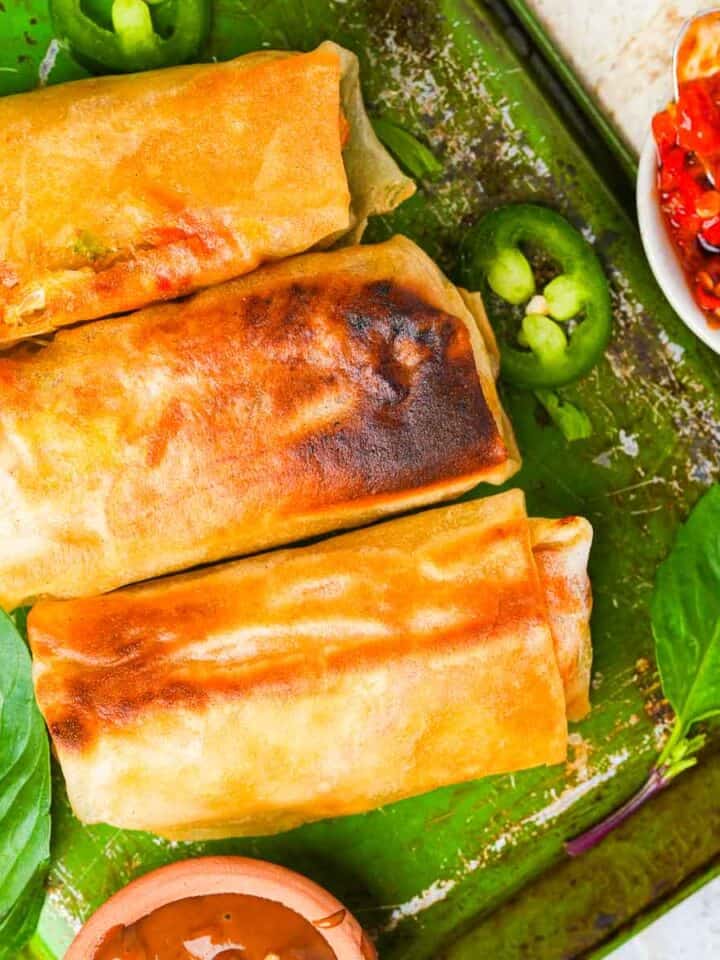
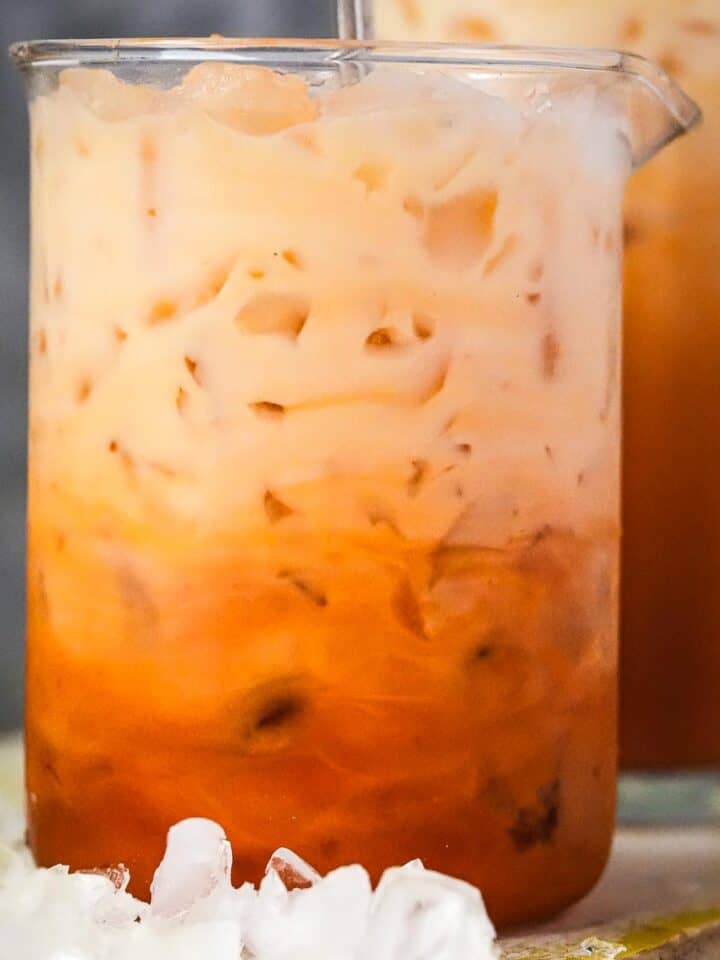
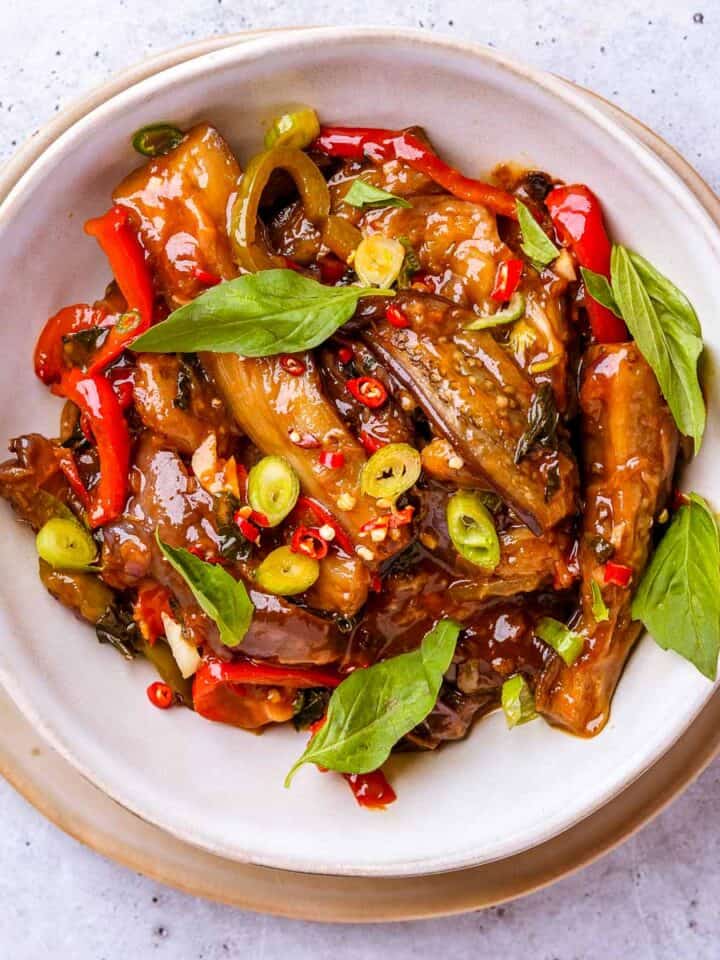
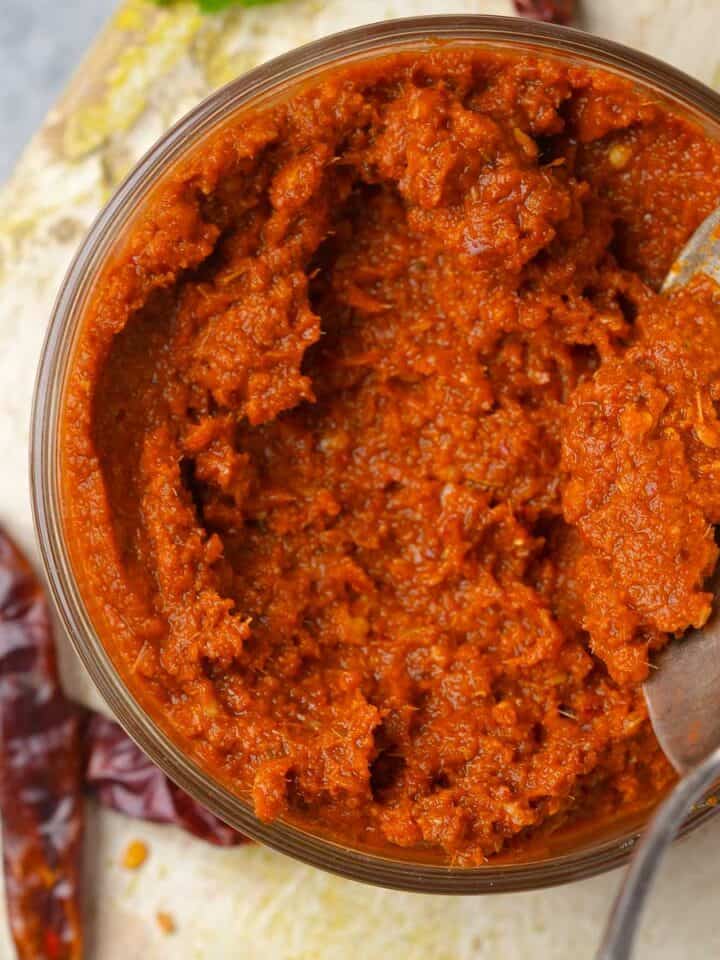

Leave a Reply